We’ve analyzed the Fintech market and outlined 5 key trends on the market. By now, you should’ve figured this one out by yourself — otherwise, you wouldn’t be reading this article at all. It may take a business analyst to probe the market for vacant niches and opportunities that others may have overlooked.
- Ideally, you should go for native iOS and Android app development to create both iOS and Android versions of your app so that no party would feel left out.
- The first step is to identify your users, including their demographics, financial behavior, and pain points.
- If you’re wondering how to build a fintech app and not overspend, we recommend launching an MVP first.
- That’s because QA testers need to ensure that all app functions are dealing with sensitive financial data and transactions properly and securely.
- This can help to identify areas of the app that require improvement or optimization.
- The financial solution you propose to create must be legally sound, and most countries have their own set of legal standards that must be met.
When the company begins to receive meaningful input from customers, the procedure can be refined and upgraded in the future. Furthermore, the technical team is always available to communicate courteously with clients. Users evaluate the app higher when it reacts quickly, solves problems, and provides feedback. Early-stage firms must provide more significant and faster assistance than competitors can. We’ve put together a step-by-step tutorial to help you to build a fintech app. It gathers and analyzes the information about people while they’re using the app, and on its basis, suggests customized operations.
Fintech App Development – A Step-by-Step Guide
Developing AI algorithms has become affordable enough to democratize access to this feature for all market players. As a result, companies with AI-powered fintech apps can better serve the needs of their customers and win a bigger share of the market. With 52% of customers naming security as their single most important concern when using a fintech app, it’s imperative to provide watertight cybersecurity measures. User authentication is among the most often used attack vectors in fintech apps, exploited by phishing, man-in-the-middle attacks, and other fraud methods.
Since this is a highly regulated environment, further tests will be needed for compliance and reporting purposes. You should have a dedicated compliance and quality management team to ensure that your app is in proper alignment with regulations. If your app accepts payments, you need to ensure that you https://www.globalcloudteam.com/ handle the risk of credit card fraud. You will need to offer a way to make secure and reliable payments, and you can use vendors like Stripe or PayPal to handle all the relevant PCI DSS regulation risks for you. It ensures the authenticity of each transaction by validating and recording each one.
Credit score checks
However, the timeline matters on several factors such as app complexity, requirements, and the type of app development you select. The United States has 10,755 fintech (financial technology) startups as of November 2021, making it the region with the most FinTech businesses worldwide. Within this model, the user pays a fee each time a transaction is made through the application.

Conduct extensive market research to identify market needs, industry trends, and potential competitors. This will help to ensure that your app is unique and addresses the needs of your target audience.. Plan and implement upgrades to the app, including major upgrades or new features, to ensure that the app remains competitive and provides value to users. Once the user interface has been defined in the Design stage, the next step is to develop the user interface using the chosen development framework.
How to Build a Fintech Mobile App in 2023: A Step-by-Step Guide
This line of products is all about being able to provide customers with financial services in a more user-friendly and cost-effective way, using technology such as APIs and the cloud. These recurring services include payments, currency exchanges, and asset management services, and all generate revenue per transaction. financial software developer A lot depends on selecting the right app architecture and tech stack, the correct API integrations, and a reliable software development provider that can deliver on their promises. Django Stars is such a provider, able to support your company throughout every step of fintech application development.

This way can harm your business, as it does not focus on what users want from the app. FinTech solutions are quickly gaining in popularity worldwide, and it can be difficult to determine which development language is best for the job. Native app development requires a separate app for each operating system, with different codebases for Android and IOS. Each language comes with its own developmental costs and time frame, so choosing the right language is crucial when developing FinTech solutions.
How to Build a Fintech App: An End-to-End Guide
So, to answer the question of “how to build a fintech app,” it’s necessary to understand what features must be implemented for each app type. They are insurance, investment, lending, banking, and consumer finance apps. Technologies improve the financial industry, so all the technologies related to the financial domain relate to the fintech industry. It includes a lot of niches, like online banking, trading platforms, NFT, blockchain, etc.
Some of these wallets support blockchain technology for storing users’ data and financial records. Generic banking apps have been around for a long time and can be found on the majority of smartphones in virtually any global region. Banking apps can be developed by corresponding financial institutions or by third parties, such as Chime or Atom Bank, for example.
Tech Stack for FinTech app development
Financial technology companies raised $210 billion in financial investments in 2021. Now is an excellent time to take advantage of the market by learning how to build a fintech application. Automated cloud infrastructure deployment and management tools like Docker, Kubernetes, and Terraform are often used to simplify fintech app development and maintenance. To get a fintech app developed for your business, get in touch with our fintech app development experts and discuss your requirements. Now that you know what technologies you can use to develop fintech apps let’s see how you can build a fintech app.
Fintech is a huge industry with a variety of verticals and business models that keep evolving and converging all the time. Let’s take a look at some of the popular areas where financial technology is being actively used these days. If you are considering building a fintech app, you’ll want to check out these categories for inspiration.
